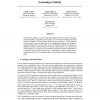Free Online Productivity Tools
i2Speak
i2Symbol
i2OCR
iTex2Img
iWeb2Print
iWeb2Shot
i2Type
iPdf2Split
iPdf2Merge
i2Bopomofo
i2Arabic
i2Style
i2Image
i2PDF
iLatex2Rtf
Sci2ools
106
click to vote
ICASSP
2008
IEEE
2008
IEEE
Learning to satisfy
This paper investigates a class of learning problems called learning satisfiability (LSAT) problems, where the goal is to learn a set in the input (feature) space that satisfies a number of desired output (label/response) properties. LSAT problems are motivated, in part, by applications in computational finance, and an experimental investigation of LSAT in the context of portfolio selection is reported. A distinctive aspect of LSAT problems is that the output behavior is assessed only on the solution set, whereas in most statistical learning problems output behavior is evaluated over the entire input space. Consequently, certain learning criteria arising naturally in LSAT problems require a novel large deviation bounding technique. 1 Learning and Satisfaction In most statistical learning problems, one is interested in minimizing a risk function such as expected squared error or probability of error. However, in many applications, one is interested in a solution to the learning prob...
ICASSP 2008 | Learning Problems | LSAT Problems | Signal Processing | Statistical Learning Problems |
Related Content
| Added | 30 May 2010 |
| Updated | 30 May 2010 |
| Type | Conference |
| Year | 2008 |
| Where | ICASSP |
| Authors | Frederic Thouin, Mark Coates, Brian Eriksson, Robert D. Nowak, Clayton Scott |
Comments (0)

